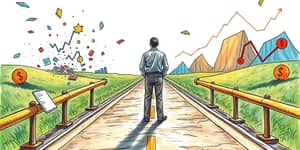
Inflation leaves a tangible imprint on every aspect of daily life. From the rising cost of groceries to the pressure on corporate margins, adjusting strategies has become not only prudent but essential. In 2025, with consumer price pressures still lingering above targets, businesses and individuals must adopt innovative and agile approaches to transform inflation from a looming threat into a platform for sustainable growth.
Data released in January 2025 shows the Consumer Price Index (CPI) increased by 3.0% year-over-year, while Core CPI, which excludes volatile food and energy components, climbed 3.3%. Essential cost categories such as fuel oil saw a 6.2% rise and motor vehicle insurance ticked up 2%, driven by higher claims and repair costs. Meanwhile, some non-essential items like apparel registered slight price declines, offering small relief in a challenging environment.
Forecasts from the International Monetary Fund (IMF) predict a global inflation rate of 4.3% in 2025, down from 5.8% in 2024 but still above the long-term target of around 2% in developed economies. Federal Reserve policymakers aim to steer inflation back to that 2% goal, but ongoing tariffs and geopolitical frictions could elevate risks, leaving the outlook more uncertain than at any time in recent memory.
In the United States, four scenarios shape potential outcomes: inflation returning to 2% if supply chain disruptions fade, persisting above 2% if labor markets remain tight, dropping below 2% amid sharp demand contractions, or surging to 6% if geopolitical shocks or wage-price spirals take hold. Each path demands tailored strategies that anticipate changing dynamics and allow for rapid adaptation.
First, adopt targeted price increases aligned with value rather than blanket hikes that risk alienating loyal buyers. Develop tiered pricing and bundling strategies tailored to segments most willing to absorb added costs, preserving premium positioning where possible.
Next, focus on a program to renegotiate vendor contracts and secure deals. Locking in long-term bulk agreements safeguards against further price erosion while improving supply visibility. For services, consider strategic outsourcing or automation of non-core functions like IT and accounting to keep labor costs in check.
To streamline workflows, establish an Inflation Council to expedite key decisions. Empower this cross-functional team with real-time dashboards to track profit performance and quickly diagnose margin leaks across channels, products, and regions.
Maintaining strong liquidity serves as an insurance policy. Aim to hold three to six months operating expenses in a high-yield emergency fund, leveraging online banks offering 4–5% APY. Explore flexible credit lines and revolving facilities that allow firms to draw on financing without the stigma or cost of new loan negotiations under duress.
Finally, the prospect of new or increased tariffs requires proactive supply chain planning and scenario modeling. Identify alternative suppliers, evaluate domestic sourcing to reduce exposure, and build selective inventory buffers. Recognize that shifting production may entail higher immediate costs but can ultimately insulate operations from sudden import duty escalations.
Inflation reshapes household spending patterns. Revisiting budgets to reflect the true cost of essentials—fuel, groceries, housing, and healthcare—is vital. Track every category closely, noting areas where costs have diverged most dramatically. Allocate additional funds for recurring expenditures such as a $2,000 auto repair versus $1,300 just a few years back.
Rebuilding an emergency buffer at current price levels requires a larger cushion. Park this reserve in instruments offering the best yields with minimal risk, such as high-yield savings accounts, short-term CDs, or Treasury bills. This approach preserves purchasing power and ensures funds keep pace with rising costs.
In portfolio construction, diversify across assets with a track record of inflation resistance. Equities typically outperform inflation over long cycles, while Treasury Inflation-Protected Securities (TIPS) offer direct linkage to changes in the CPI. Commodities like oil, natural gas, and agricultural products can react quickly to price trends, though they carry higher volatility. Real estate and REITs provide rental income that resets at prevailing rates.
During episodes of market turbulence, the difference between reacting emotionally and staying invested can be stark. Adopting a dollar-cost averaging strategy to smooth purchases helps mitigate the regret of buying at peaks. Consistent contributions, even when volatility feels uncomfortable, can yield significant long-term gains as markets recover.
Tariffs remain a wildcard. Industries heavily reliant on imports may face steeper cost pressures, while domestically focused businesses could benefit as substitution switches favor local suppliers. Each company must run scenario analyses to gauge the impact of potential changes and adjust procurement strategies accordingly.
Labor market dynamics are equally critical. Tightness in skilled roles can trigger wage-driven inflation, passing on higher costs through the value chain. Organizations should weigh investments in automation and employee upskilling to alleviate manpower shortages and stabilize long-term cost structures.
Geopolitical tensions and unpredictable supply chain shocks keep the risk landscape in flux. Businesses must maintain multiple sourcing strategies and continuous monitoring, diversify logistics routes, and use predictive analytics to detect early warning signals. Building strong relationships with key suppliers ensures preferential access when capacity strains peak.
Inflation often triggers instinctive defensive reactions—cutting costs aggressively or hoarding cash. While prudent, defense alone can leave opportunities on the table. Leading organizations balance discipline with strategic investment in growth areas, such as digital transformation, new product development, and targeted marketing campaigns that capture shifting consumer preferences.
Individuals who integrate inflation awareness into financial planning develop a mindset of opportunity recognition. Rising prices can prompt skill development for higher-earning roles, entrepreneurial ventures that solve newly urgent problems, and creative optimization of everyday expenses to free up resources for future goals.
Ultimately, the most successful strategies turn inflation from a barrier into a catalyst for improvement. By combining robust cost management frameworks with bold measures in pricing, investment, and innovation, businesses and households alike can emerge more efficient, more adaptable, and better positioned for sustained success in a world of evolving price dynamics.
References













